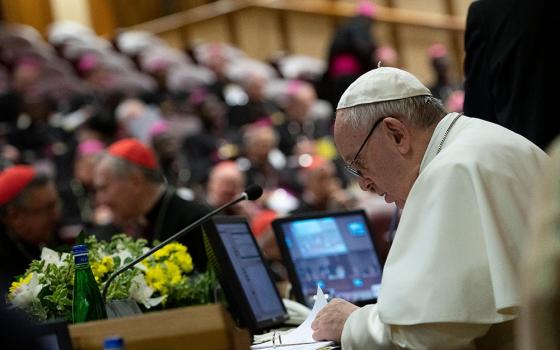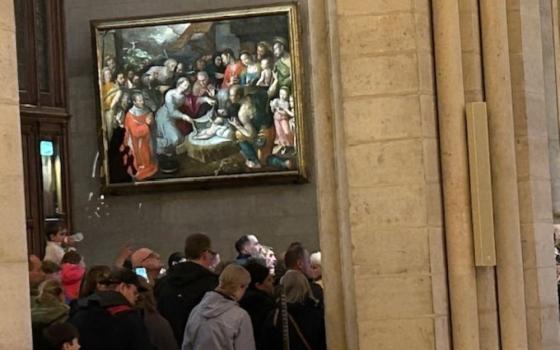Archbishop Miguel Cabrejos Vidarte of Trujillo, Peru, visits a settlement in La Esperanza district, in Trujillo, on June 5, 2023, and donates two houses to residents who lost their homes during the floods that hit northern Peru in March. The rains and floods helped to propagate the dengue virus epidemic in the country, which resulted in at least 248 deaths and 146,000 cases. (OSV News/courtesy Trujillo Archdiocese)
Cyclone Yaku's path through Peru's northern region in March was so destructive that its direct effects — such as the destruction of homes by floods and landslides — and indirect effects — especially an unprecedented outbreak of dengue fever — are still being felt today.
In cities such as Trujillo and Piura, people who lost everything in the rains have faced not only unemployment and food shortages but also the struggle against Aedes aegypti — the dengue-transmitting mosquito that has reproduced prolifically in the many areas still flooded.
With more than 160,000 people infected by the disease and at least 287 deaths, Peru is experiencing one of the worst dengue epidemics in its history. It has become the country with the second highest number of cases in the Americas, after Brazil.
The outbreak resulted in thousands of ill teachers, leading school officials to opt for distance learning. Various sectors of society have been severely affected, and health services have been unable to meet the high demand.
Dioceses and church organizations have been working continuously to help cyclone victims and the sick, distributing donations and being present in the most affected districts.
"After the cyclone and the landslides, many disasters will follow. Many families lost everything, including their houses, taken by the mud," described Sr. Rocio Zapata, secretary general of Caritas in the Archdiocese of Trujillo.
Advertisement
An emergency solidarity campaign, coordinated by Caritas Peru since the end of March, collected donations from individuals, companies and NGOs. Diocesan and parish Caritas affiliates rushed to distribute food, drinking water and clothing to thousands of families.
"We also received a cash donation from the Holy See. In Trujillo alone, more than 2,500 families have been helped since then," said Rocio, a member of the Congregation of the Sisters of Bon Secours.
The Catholic movements organized "ollas comunes," or soup kitchens, with parish-supplied food in all the affected regions. In just one of the districts of the Archdiocese of Trujillo, for example, there are 30 ollas comunes, she said.
"That way, people can have at least one full meal throughout the day," she explained.
Volunteers have been visiting the homes of families in need. Often, they return with much-needed items such as mattresses and roof tiles for the houses.
"With so many cases of dengue, some of our sisters ended up contracting the disease, even though we did the necessary fumigation to kill the mosquito," Rocio added.
A little over two weeks ago, Archbishop Miguel Cabrejos Vidarte of Trujillo visited the human settlement Ampliación Clementina Peralta in the district of La Esperanza and delivered two prefabricated houses to families who had lost their homes during the rains.
A health worker sprays fumigation vapor to stem the spread of dengue virus at the Nueva Esperanza cemetery in Lima, Peru, June 1, 2022. This year, Peru is going through one of the worst dengue epidemics in its history and has become the country with the second highest number of cases in the Americas. (OSV News/Reuters/Sebastian Castaneda)
"Another frequent donation is suero (oral rehydration solution) and paracetamol. The most important thing in dengue is to maintain hydration. We take it to the homes of the sick," Rocio said.
In Piura, where more than 44,000 people are infected, the church has continuously donated medicine to clinics treating dengue patients.
On June 8, Archbishop José Antonio Eguren of Piura visited the José Cayetano Heredia hospital to deliver various medicines, the third such donation of medicine made by the archdiocese to the hospital.
"Following the example of our Lord Jesus Christ, the church is committed to the integral health of the human person. She seeks to heal both the wounds of the body and those of the soul; she prays and acts for the physical and spiritual healing of the human person," said Eguren during the meeting at the hospital.
The severe dengue outbreak in Peru will likely continue to affect vulnerable communities for some time. On June 17, Health Minister Rosa Gutiérrez Palomino resigned amid severe criticism in Congress for her handling of the epidemic.
Local dioceses and Caritas continue to call on Peruvian society to continue to support donations.







